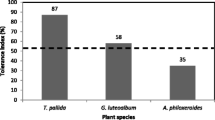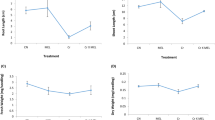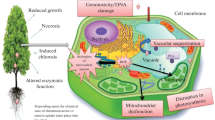Abstract
Effect of chromium (both CrIII and CrVI) were studied on the oxidative damages and the induction of antioxidant defence in turnip. For this purpose turnip (Brassica rapa L.) plants were grown in refined sand under three different sources of chromium, i.e., chromium sulphate (CrIII), potassium chromate (CrVI) and potassium dichromate (CrVI) supplied at 250 µM concentrations for 4, 24 and 168 h (7 days) after 50 days of growth in normal nutrition. The extent of oxidative damage was most in dichromate as it caused a maximum increase in lipid peroxidation and H2O2 concentration in leaves of turnip plants. The growth and biomass of plants decreased, while the levels of chloroplastic pigment and iron increased in plants supplied CrVI (both potassium chromate and potassium dichromate). Exposure of plants to Cr led to increase in Cr concentration, more in the roots than in shoots. Excess supply of Cr (chromium sulphate, potassium chromate and potassium dichromate), though inhibited peroxidase activity (at 4 and 168 h exposure), stimulated catalase, ascorbate peroxidase and superoxide dismutase activities. Localization of different isoforms of APX and SOD on native gels revealed activation of certain isoform in the Cr-treated plants.



Similar content being viewed by others
References
Beauchamp, C., & Fridovich, I. (1971). Superoxide dismutase: Improved assays and assays applicable to acrylamide gels. Analytical Biochemistry, 44, 276–287.
Brennan, T., & Frankel, C. (1977). Involvement of hydrogen peroxide in regulation of senescence in pear. Plant Physiology, 59, 411–416.
Chatterjee, J., & Chatterjee, C. (2000). Phytotoxicity of cobalt, chromium and copper in cauliflower. Environmental Pollution, 109, 69–74.
Choudhury, S., & Panda, S. K. (2005). Toxic effects, oxidative stress and ultrastructural changes in moss Toxithelium nepalense (Schwaegr) Broth. Under chromium and lead phytotoxicity. Water, Air, and Soil pollution, 167, 73–90.
Dixit, V., Pandey, V., & Shyam, R. (2002). Chromium ions inactivate electron transport and enhance superoxide generation in vivo in pea (Pisum sativum L cv. Azad) root mitochondria. Plant, Cell and Environment, 25, 687–693.
Dube, B. K., Tewari, K., Chatterjee, J., & Chatterjee, C. (2003). Excess chromium alters uptake and translocation of certain nutrients in citrullus. Chemosphere, 164, 793–801.
Dube, B. K., Sinha, P., Gopal, R., & Chatterjee, C. (2004). Chromium phytotoxicity alters metabolism in radish. Journal of Vegetable Crop Production, 10, 61–71.
Heath, R. L., & Packer, L. (1968). Photoperoxidation in isolated chloroplasts, I. kinetics and stoichiometry of fatty acid peroxidation. Archives of Biochemistry and Biophysics, 125, 180–198.
Hewitt, E. J. (1966). Sand and water culture methods used in the study of plant nutrition (2nd ed.). London: Technical communication No. 22, Common Wealth Agricultural Bureau.
Kappus, H. (1985). Lipid peroxidation: Mechanisms, analysis, enzymology and biological relevance. In H. Sies (Ed.), Oxidative stress (pp. 273–310). London: Academic Press.
Katz, S. A., & Salem, H. (1994). The biological and environmental chemistry of chromium. New York: VCH Publishers.
Kotas, J., & Stasicka, Z. (2000). Chromium occurrence in the environment and methods of its speciation. Environmental Pollution, 107, 263–283.
Lichtenthaler, H. K. (1987). Chlorophylls and carotenoids: pigments of photosynthetic biomembranes. Methods in Enzymology, 148, 350–382.
Liu, C., Du, W., Cai, H., Jia, Z., & Dong, H. (2014). Trivalent chromium pretreatment alleviates the toxicity of oxidative damage in wheat plants exposed to hexavalent chromium. Acta Physiologiae Plantarum, 36, 787–794.
Lowry, O. H., Rosebrough, N. J., Farr, A. L., & Randall, R. J. (1951). Protein measurement with folin-phenol reagent. Journal of Biological Chemistry, 193, 265–275.
Marschner, H. (1995). Mineral nutrition of higher plants. London: Academic Press.
Mittler, R., & Zilinskas, B. A. (1993). Detection of ascorbate peroxidase activity in native gels by inhibition of ascorbate-dependent reduction of nitroblue tetrazolium. Analytical Biochemistry, 212, 540–546.
Nakano, Y., & Asada, K. (1981). Hydrogen peroxide is scavenged by ascorbate specific peroxidase in spinach chloroplasts. Plant and Cell Physiology, 22, 867–880.
Nieboer, E., & Richardson, D. H. S. (1980). The replacement of nondescript term “heavy metals” by a biologically and chemically significant classification of metal ions. Environmental Pollution, B1, 3–26.
Oliveira, H. (2012). Chromium as an environmental pollutant: Insights on induced plant toxicity. Journal of Botany, 2012, 8.
Paiva, L. B., de Oliveira, J. G., Azevedo, R. A., Ribeiro, D. R., daSilva, M. G., & Vitoria, A. P. (2009). Ecophysiological responses of water hyacinth exposed to CrIII and CrVI. Environmental and Experimental Botany, 65, 403–409.
Panda, S. K. (2007). Chromium-mediated oxidative stress and ultrastructural changes in root cells of developing rice seedlings. Journal of Plant Physiology, 164, 1419–1428.
Panda, S. K., & Choudhury, S. (2005). Chromium stress in plants. Brazilian Journal of Plant Physiology, 17, 95–102.
Panda, S. K., & Khan, M. H. (2003). Antioxidant efficiency in rice (Oryza sativa L.) leaves under heavy metal toxicity. Journal of Plant Biology, 30, 23–29.
Panda, S. K., & Upadhyay, R. K. (2008). Biochemical changes and oxidative damage in Azolla pinnata L. under chromium phytotoxicity stress. Indian Journal of Plant Physiology, 13, 243–250.
Panda, S. K., Choudhury, I., & Khan, M. H. (2003). Heavy metals induce lipid peroxidation and affect antioxidants in wheat leaves. Biologia Plantarum, 46, 289–294.
Pandey, N., & Sharma, C. P. (2003). Chromium interference in iron nutrition and water relations of cabbage. Environmetal and Experimental Botany, 49, 195–200.
Pandey, V., Dixit, V., & Shyam, R. (2009). Chromium effect on ROS generation and detoxification in pea (Pisum sativum) leaf chloroplasts. Protoplasma, 236, 85–95.
Shanker, A. K., & Pathmanabhan, G. (2004). Speciation dependant antioxidative response in roots and leaves of Sorghum (Sorghum bicolor (L) Moench cv CO 27) under Cr(III) and Cr(VI) stress. Plant and Soil, 265, 141–151.
Sharma, D. C., & Sharma, C. P. (1996). Chromium uptake and toxicity effects on metabolic activities in wheat, Triticum aestivum L. cv. UP 2003. Indian Journal of Experimental Biology, 34, 689–691.
Tewari, R. K., Kumar, P., & Sharma, P. N. (2010). Morphology and oxidative physiology of boron-deficient mulberry plants. Tree Physiology, 30, 68–77.
Welch, R. M., Allaway, W. H., House, W. A., & Kubota, J. (1991). Geographic distribution of trace element problems. In J. J. Mortvedt, F. R. Cox, L. M. Schuman, & R. M. Welch (Eds.), Micronutrient in Agriculture (pp. 31–37). Wisconsin: Soil Science Society of America.
Zayed, A., Lytle, C. M., Qian, J. H., & Terry, N. (1998). Chromium accumulation, translocation and chemical speciation in vegetable crops. Planta, 206, 293–299.
Zeid, I. M. (2001). Responces of Phaseolus vulgaris to chromium and cobalt treatments. Biologia Plantarum, 44, 111–115.
Author information
Authors and Affiliations
Corresponding author
Rights and permissions
About this article
Cite this article
Chatterjee, J., Kumar, P., Sharma, P.N. et al. Chromium toxicity induces oxidative stress in turnip. Ind J Plant Physiol. 20, 220–226 (2015). https://doi.org/10.1007/s40502-015-0163-6
Received:
Accepted:
Published:
Issue Date:
DOI: https://doi.org/10.1007/s40502-015-0163-6




